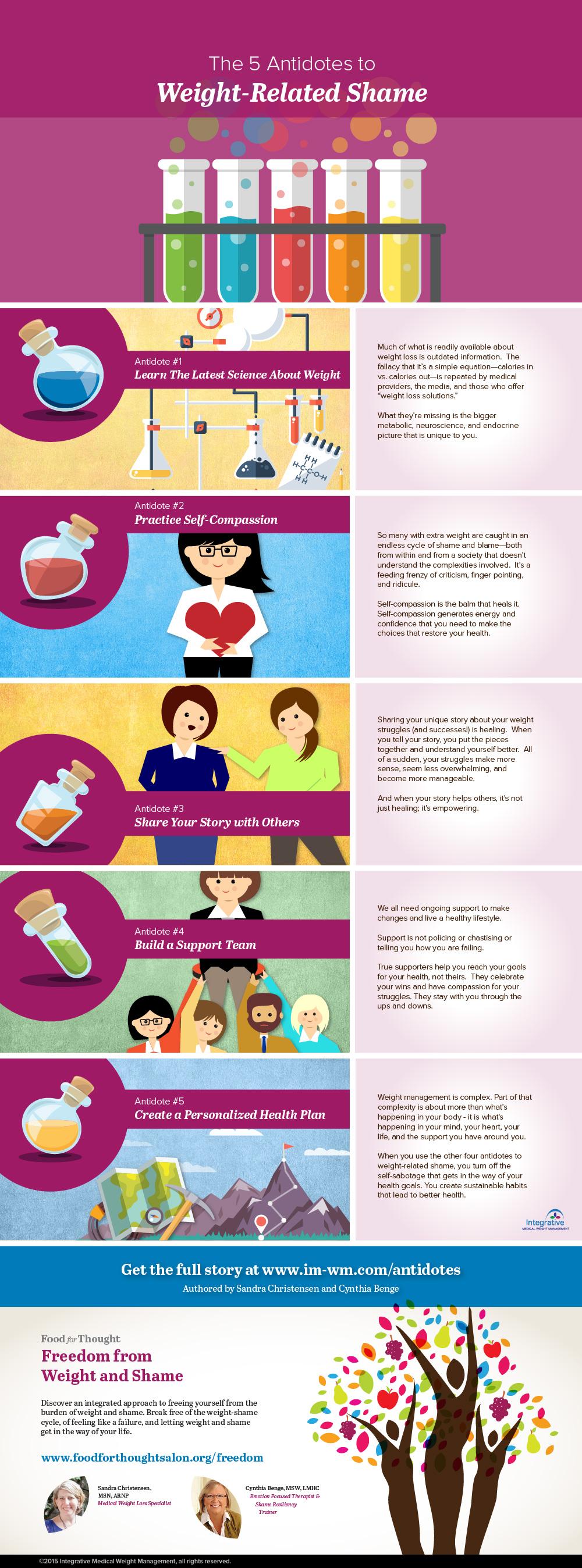Developed in collaboration with Cynthia Benge, psychotherapist and shame resiliency trainer.
(Don’t miss the two resources I created for you – The Weight Blueprint, Build Your Support Team – you can get below!)
Have you ever held back or said no to an opportunity, experience, or even a simple joy of life because of your weight?
If so, I’d like to give you the five antidotes to weight-related shame, so you can get your life back on track!
View the full infographic at the end of this post!
If you’ve struggled with weight, you’ve probably felt that tangled mix of emotions that can often come with it—embarassment, fear, inadequacy, failure, shame.
It comes from the people around us. It comes from the media, our doctors, our culture, and sometimes even from within…
It should be easy, right? Eat less, exercise more. We wonder what is wrong with us and think, “Why can’t I be like them?”
Let me reassure you: It’s not your fault.
It’s time to stop letting yourself or anyone else shame you or define who you are based on your weight. There are 5 key antidotes to weight-related shame and I’m going to share each one with you.
Now, let’s begin with the first antidote – starting with realizing exactly WHY it’s not your fault so you can move from a place of power instead of weight loss failure…
1. Learn The Latest Science About Weight
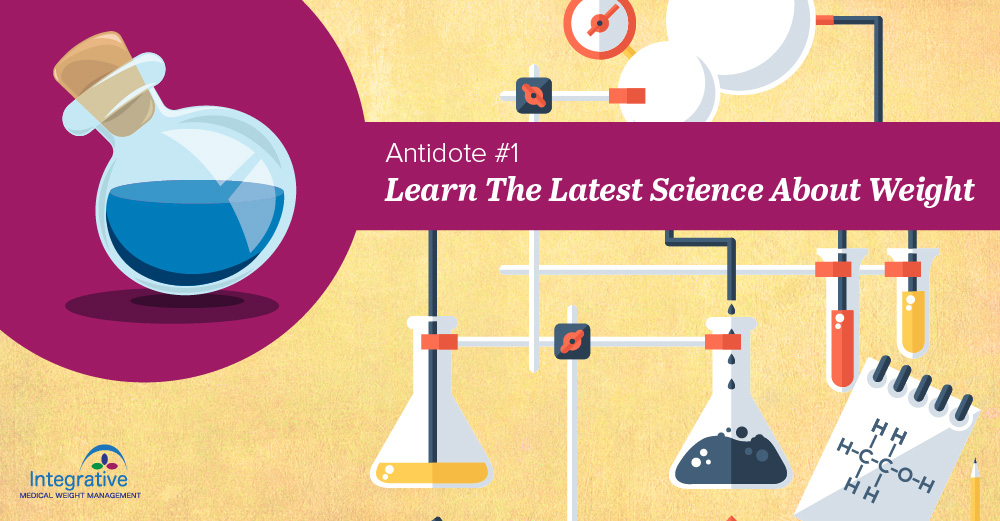
Remember how I said it’s not your fault? It’s not, and the first step is to understand why.
For many, weight loss is like a trick question. The answer seems obvious, but our own body keeps telling us we’re wrong as it refuses to slim down an inch further. It all seems like a cruel joke. Others may blame us for failing, and we may also blame ourselves.
But like a trick question, we’re missing an important piece of information that changes our whole perspective.
Everyone thinks the answer is obvious, but they are operating on outdated information.
Much of what is readily available about weight loss is outdated information. The fallacy that it’s a simple equation—calories in vs. calories out—is repeated by medical providers, the media, and those who offer “weight loss solutions.”
What they’re missing is the bigger metabolic, neuroscience, and endocrine picture that is unique to you, and that is far more complex than calories consumed vs. calories burned. It is what I teach my patients day after day. Once they see the reality, their whole perspective shifts and they start to see the trick in the trick question of weight loss.
There are many factors that can silently sabotage your weight or cause weight gain that are unique to you:
- Medical conditions
- Certain medications
- Environmental factors
- Brain chemistry
- Metabolic factors
But once we find the root of the problem holding back your progress, we can finally address it with a solution. But many doctors aren’t even aware of the full weight picture, or what can cause weight gain.
In fact, I put together The Weight Blueprint to show you the many hidden causes of weight that have nothing to do with food or exercise. All so you can start to find the real problem and know you aren’t to blame.
Grab it here:

Get my full Weight Blueprint to identify the 24 hidden causes of weight revealed by science
See exactly what could be keeping you stuck in your weight goals... So you can do something about it!
Send My Free GuideWhen they do, they start to understand what is really happening, which is the first step to finding a new path.
Which brings us to the next antidote…
2. Practice Self-Compassion
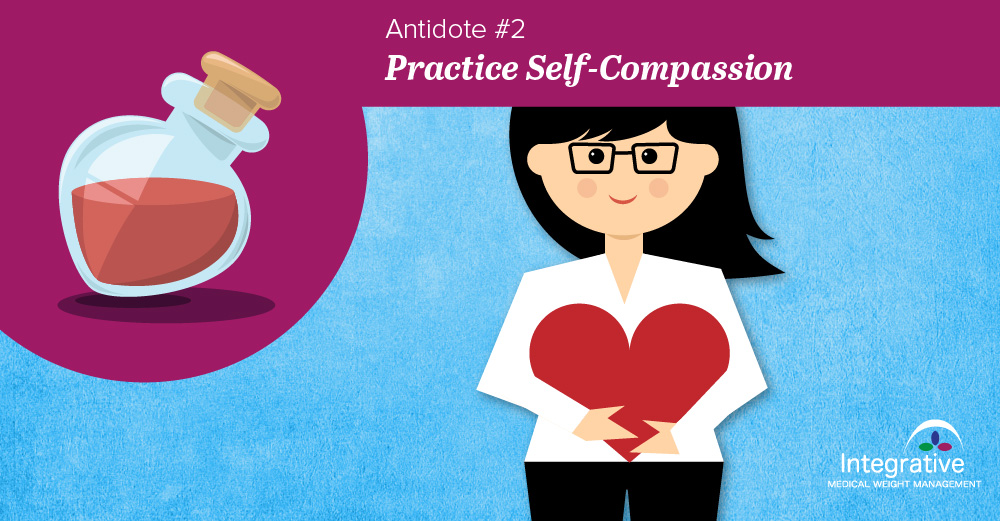
The shame that comes with living in a world that doesn’t understand the realities and complexities of weight issues immobilizes us.
Feelings of shame, fear, insecurity, inadequacy, failure, embarrassment sear us like a hot coal.
So many with extra weight are caught in an endless cycle of shame and blame—both from within and from a society that doesn’t understand the complexities involved. It’s a feeding frenzy of criticism, finger pointing, and ridicule.
The shame and blame leads to further weight gain, which triggers more shame and blame. As the cycle continues, we burn and smolder.
Self-compassion is the balm that heals it.
And now that you know the full weight picture outlined in The Weight Blueprint, you can see why the blame is unfounded. Understanding is the first step to compassion, which is why it is Antidote #1.
Have you ever felt that energy drain of blame and shame? Self-compassion is the opposite. It generates energy—energy and confidence you need to make the choices that restore your health.
Self-compassion frees up the energy you need to focus on achieving your health goals and enjoying life.
Thankfully, there are simple practices that can bring you back to a place of compassion for yourself, rather than the blame and judgment that immobilize you.
With compassion, you can begin the third antidote to shame…
3. Share Your Story With Others
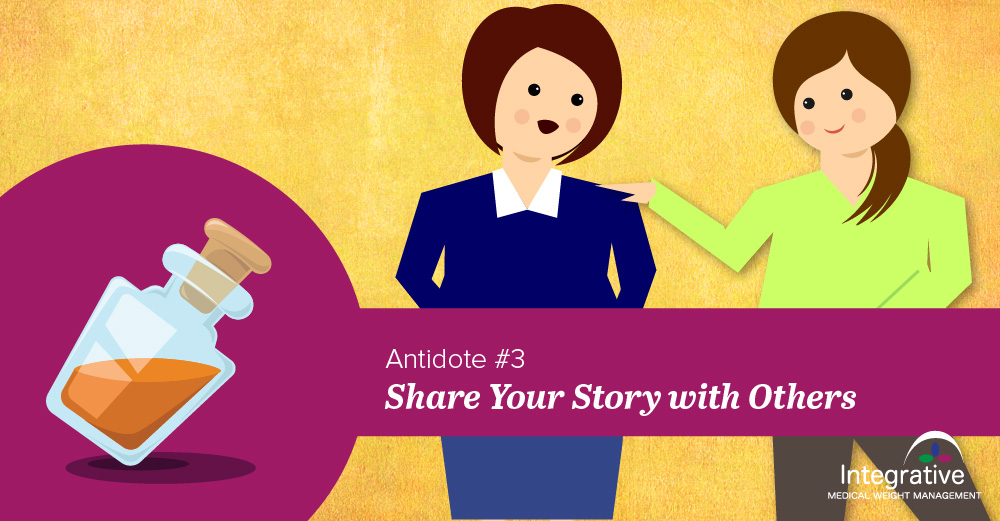
Wait, don’t run away yet!
Sharing can be scary, but sharing your story with those who understand and support you is incredibly healing.
Have you ever felt the tremendous relief when you talk to someone with the same gripe you have and all of a sudden you can really share? No more holding back pretending everything is fine. No more balling up the growing tension inside you.
Instead, there’s a gush of relief as your story tumbles out and someone is right there with you to receive it.
Maybe it’s a coworker struggling with the same irritating micromanagement by your boss. Or another mother whose teenage hellions stormed out of the house that very morning.
Sharing your unique story about your weight struggles (and successes!) is healing. When you tell your story, you put the pieces together and understand yourself better. All of a sudden, your struggles make more sense, seem less overwhelming, and become more manageable.
When your story is received with compassion and understanding by others, it heals you on a deep level.
And when your story helps others, it is not only healing, it’s empowering.
But it is important to do this only with those who understand the complexities of extra weight and will not judge you.
Who can you share it with? That’s next…
4. Build a Support Team
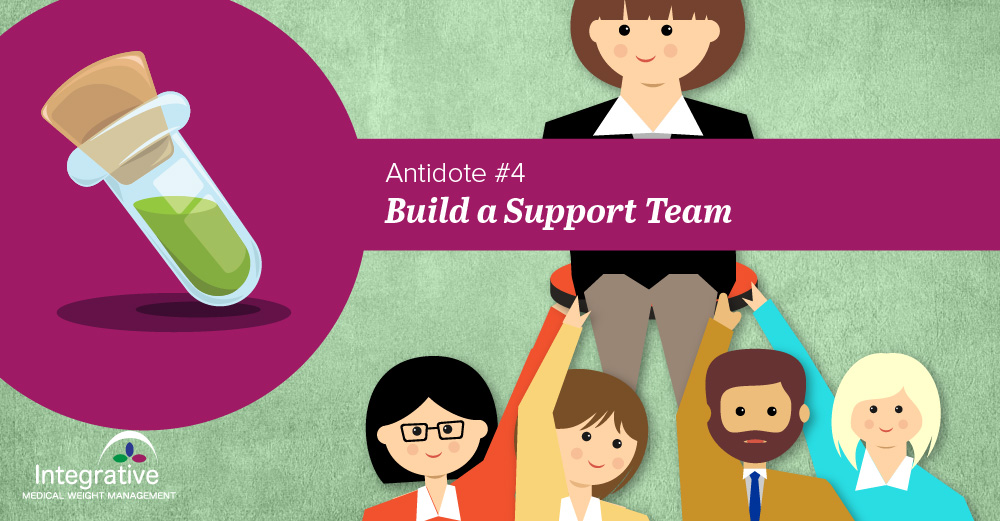
We all need ongoing support to make changes and live a healthy lifestyle.
Friends, family, coworkers, professionals, people on your same journey – they can all help form your support team.
Support is not policing or chastising or telling you how you are failing. A support team builds you up instead of tearing you down.
A good support team changes your life, often in ways you didn’t think were possible. But it takes the right people and the right roles to get the support you need from the people in your life..
I’ve put together the perfect guide to getting the support you need from the people in your life to achieve your weight goals. Get the guide and worksheet here:

How to Get the Support Team You Need to Thrive!
The people around you and the support they give is the defining factor between happy and healthy or shamed and crumbling.
Send My Free GuideThe best supporters for sharing your story already know exactly what you are going through. But instead of having a pity party, you actively support and build one another. You celebrate your wins and have compassion for your struggles. You help one another see the best in yourselves, and shift your perspectives when the shame and blame start to seep in.
So what’s left? You see through the trick question of weight loss, you develop self-compassion, you share your story, and you build a supportive team around you… Now it’s time to create a personalized health plan based on truth instead of the prevalent fiction that’s keeping you down.
5. Create a Personalized Health Plan

“But wait!” you cry out, “Why can’t I just start with this??”
You may be thinking, “I just need the formula to lose this weight and I’ll be good.”
You may even be thinking, “I can skip the rest of it if you just give me the solution.”
Remember Antidote #1? Not the part about “It’s not your fault.” I’m talking about the part where you discover the complex realities of weight management.
Weight management is complex. If it was as simple as less calories and more exercise, you wouldn’t be here.
Part of that complexity is about more than what’s happening in your body – it is what’s happening in your mind, your heart, your life, and the support you have around you.
When you use the other four antidotes to weight-related shame, you turn off the self-sabotage that gets in the way of your health goals. You create sustainable habits that lead to better health.
You are okay with who you are, where you are right now, and can more easily see where you need to go next.
And that will have the greatest effect on your health and your life. If you can’t enjoy life, feel good about yourself, and feel confident and supported… you will have a harder time achieving your goals.
Then you can address your full health picture. All of these are part of your personalized health plan. Enjoying your life is the ultimate goal!
Your personalized health plan includes attention to:
- Eating plans for your body and lifestyle, based on modern science
- Healthy movement (not necessarily “exercise”)
- Uncovering the hidden physiological issues that affect your weight and health
- Adequate sleep & rest
- Stress reduction
- Participating in enjoyable activities
- Connecting with others and building a support team
- Regular visits with knowledgeable, supportive healthcare providers
Understanding the complexity of weight and discovering the hidden factors in your own body are both critical to developing a personalized health plan.
Having a personalized health plan gives you the confidence and hope to move forward, create sustainable changes, and enjoy life!
Resources:

Download the 5 Antidotes to Weight Shame
Get the PDF to print, share, and remind yourself of the steps to free yourself from the burden of weight-shame forever.
Send My Free Guide


